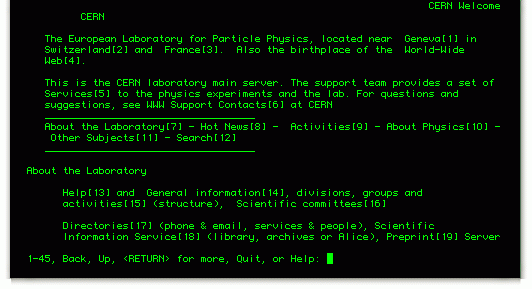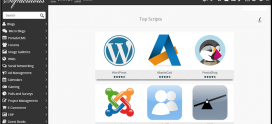
Web Designing has Evolved since 1980s
Web designing evolution.
Web Destining is evolved since it was first started by CERN as Hyper Text in 80s and then evolved HTML Blow is the timeline since then till today.
1989 – First Website Project
Berners-Lee in 1989 proposed to create a global hypertext project in CERN which is now known as the World Wide Web

90s – The Innovation
Web designing evolved with the evolution of technology. Software and tools brought many changes the way website were designed here is brief history during 90s period.
Early 90s
Somewhere between 1991 and 1993 the web pages started to evolve. the platform were mainly Unix based text pages were made during this period with no integrated approach.
This First web page was made in 1992 called (Word Wide Web)
Initial versions of HTML (HyperText Markup Language) only allowed for very basic content structure: headings (<h1>, <h2>, etc.), paragraphs (<p>), and links (<a>).
October 1994, Tim Berners-Lee founded the World Wide Web Consortium (W3C) at the Massachusetts Institute of Technology, Laboratory for Computer Science
Yahoo website and it’s messenger brought a revolution in websites world.
Mid 90s
New version of HTML allowed the addition of images (<img>) to pages, and eventually support for tables (<table>) was added.
www became the common protocol for web desining.
Vermeer FrontPage 1.0 was launched in 1995 with later became Microsoft Front Page 1.1 in 1196 for Web Page Designing. PHP 1.0 was also launched during 1995. Followed by ASP 1.0 in 1996.
Similarly, HoTMaiL in 1994 acquired by Microsoft in 1996 or 1997 as Hotmail and then MSN Website and Messenger.
Late 90s
Web Browsers war began and this became an opportunity for many individual programmers and companies.
Microsoft Windows 95 (New Version in 1997) had Internet Explorer as key feature of the Operating System as an enhancement to previous version. Microsoft also included FrontPage 1997 in its office suit application which gained popularity and almost every web designer considered it as must have for web page design.
Opera 1.0 was launched during this period.
Altavista Search English got popularity during in late 90s, engaging designers for SEO. The term Search Engine Optimization first appeared in May 1997.
Netscape got the popularity and people but the fight continued and helped many designers and developers to improve technologies.
During this period Cascading Style Sheets (CSS), Java Script and Dynamic HTML and many new technologies were also born.
MacroMedia Launched Flash, Dreamweaver and Fireworks Applications initially for Mac. In 1998 first version for Windows was launched.
Flash and animated GIF and Java Script for widgets gained popularity.
robots.txt standard (Robots exclusion standard or Robots exclusion protocol) as part of the W3C www-talk mailing list. The rules defined in the robots.txt file are used to prevent or restrict indexing robots from accessing a website.
Favicon (a combination of the words favorite and icon) first appeared in Internet Explorer 5.0
e-Commerce Website
Though Electronic commerce was not new, eCommerce existed before www existence but eCommerce website opened new doors for eCommerce and first eCommerce website by Amazon was launched in 1995 to Auction the books.
Online Payment Gatway
PayPal being the first online payment gateway started its first service in 1998
2000 – The big year
Internet Explorer was launched for MAC and at the same time Netscape communicator was also launched which support and creating more opportunities for web designers .
Browsers supported PNG Image format, CSS became very popular.
Netscape was sold to AOL as it lost the war with Microsoft. Microsoft also provided FrontPage Desktop Application
2001-2010 – The Internet Revolution
This period was mainly called the decade of design. During these 10 years Internet and Telecommunication evolved and it brought business opportunities. Many companies gained popularity which no one new before.
Blogging
Pyra Labs launched one of the oldest blogging tools at Blogger.com. The new blogging platform gained a large community of users in the subsequent years. In February 2003, Blogger.com was bought by Google.
(Web Log) Blogging became common and many individuals started designing their own blog site.
New graphics like stylish buttons, rounded shapes, mouse over effects, music and media in website became popular.
Web2.0, HTML5 , Ajaand CSS3 and JavaScript APis were commonly used for programming. Graphic designing including Vector and raster graphics editors gained popularity to create websites graphics.
The raise of Mobile Apps and Web Applications took place during this period and responsive web designing became USP for web designers.
In 2009, grid layouts of website became common.
Adobe
Adobe acquired Macromedia. Flash and Dreamweaver got branded with Adobe.
Firefox
Firefox entered into web and launched first version of web browser Firefox 1.0 on November 9, 2004.
XML
Hundreds of XML-based languages got developed, including RSS, Atom, SOAP, and XHTML. XML-based formats have become the default for many office-productivity tools, including Microsoft Office (Office Open XML), OpenOffice.org and LibreOffice(OpenDocument), and Apple’s iWork. XML has also been employed as the base language for communication protocols, such asXMPP.
Wikipedia
Jimmy Wales and Larry Sanger founded Wikipedia, a multilingual internet encyclopedia. The content of the encyclopedia is shared under a free and open license of the Creative Commons. Volunteer contributors from around the world participate in the creation of Wikipedia entries.
Social Networking sites
Improvement in web designing tools helped companies and individuals to connect the people. Social Networking web sites became popular during 2005-2010
– Myspace 2004
– Flickr 2004
– Digg 2004
– YouTube 2005
– Reddit 2005
– Twitter 2006
– Facebook 2006
– Tumblr 2007
– Google+ 2011
The browser was first publicly released on September 2, 2008 for Windows XP and later, with 43 supported languages, officially a beta version, and as a stable public release on December 11, 2008.
WordPress
WordPress first appeared in 2003 as a joint effort between Matt Mullenweg and Mike Little to create a fork of b2. The first version of the open source content management system called WordPress 0.7. The publishing system is based on PHP and MySQL technology and is developed under the GNU GPL free software license. The predecessor of WordPress was the b2/cafelog blogging platform. It is most popular and common CMS tool and end of 2010 around 33 % websites are made on this platform and at present in 2019 almost 68% websites built on WordPress.
Joomla
Launched in 2005, Joomla is almost just as old as WordPress. Behind WordPress, Joomla is the second most popular content management system, powering around 3% of all the websites on the Internet and holding 5.4% of the content management system market.
There were many improvements during this decade and the year 2010 ended with Responsive Web Design.
2010-2019
During this decade their are uncountable improvements and many old technologies like Flash was discarded. In web browsing Microsoft Edge was the biggest change by Microsoft.
Progressive Web Apps, Accelerated Mobile Pages, Voice search optimization, API development, Push notifications, AI-powered chat bots and Motion UI are key concepts that designers and developers have to consider while desining the websites.
Today there are many technologies to develop the website but most popular are Adobe Dreamweaver CC, Bluefish , Atom Text Editor , Google Web Designer , Webflow and finally the most common where almost 70% of websites are made on this platform is WordPress.
Though, there are some end user web designing tools like wix.com but I am not considering them as web designing tools. Although, wordpress is also in some cases end user designing but integration and design still keeps the wordpress at top.
Not everything is covered in this blog but most common tools and technologies are listed below which were introduced or evolved during this decade.
Bootstrap
Web developers Mark Otto and Jacob Thorton of Twitter began creating the CSS framework Bootstrap in mid-2011. The framework was originally developed to help maintain the HTML/CSS and JavaScript code consistency in Twitter applications. In August 2011, Bootstrap 1 was released as an open source tool and is currently one of the most popular CSS frameworks among web designers. In January 2012, Bootstrap 2 was released, supporting a responsive web layout.
Material Design
Google introduced a new graphic style called Material Design at the Google I/O conference. Since 2015, Google has redesigned most of its applications and services using the consistent visual style of Material Design. According to Google’s definition, Material Design is a “visual language that synthesizes the classic principles of good design with the innovation and the possibility of technology and science.”
HTML5
W3C adopted the final recommendation for the HTML5 markup language. The HTML5 version has brought an improved browser multimedia playback support, new semantic tags that better define page structure, offline application support, and the <canvas> tag that can interpret vector graphics with an option to insert images.


